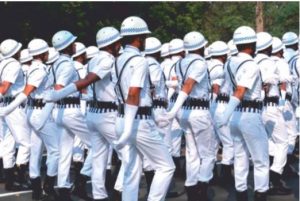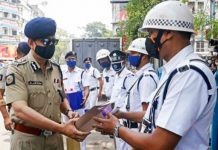Samrat Mukhopadhyay,
Department of Textile and Fibre Engineering IIT Delhi
What is comfort?
Comfort involves a balance of physiological, psychological and physical aspects between a person and the environment. Clothing comfort is commonly associated with stimuli and sensations that garments feel with change in human activity and the microclimate.
Where is the challenge with uniforms for police?
Personnel in police force can be considered to be members of the active population. However, little thought have gone behind designing of garments of police/guards on duty. Reduced productivity arises from several issues, including the weight and bulk of the clothing, visual and tactile reductions associated with some clothing, and heat stress which typically accompanies the wrong choice of clothing. Active participation in any activity will raise the metabolic rate, therefore, raising the heat produced by the worker. While this may be an advantage in cold environments, in warm/hot environments, this further raises the requirements for heat dissipation.
 The problem gets compounded in regions of high temperature and humidity. Humans working at moderate (e.g. a Traffic police) or higher metabolic rates need to get rid of the metabolic heat via sweat evaporation from the skin. Wrong type of garments would reduce sweat evaporation, consequently reducing the rate of heat loss. Impermeable clothing will retard sweat evaporation, but even permeable clothing can raise the water vapor pressure over a period of time, slowing the rate of evaporation and heat dissipation.
The problem gets compounded in regions of high temperature and humidity. Humans working at moderate (e.g. a Traffic police) or higher metabolic rates need to get rid of the metabolic heat via sweat evaporation from the skin. Wrong type of garments would reduce sweat evaporation, consequently reducing the rate of heat loss. Impermeable clothing will retard sweat evaporation, but even permeable clothing can raise the water vapor pressure over a period of time, slowing the rate of evaporation and heat dissipation.
Let us look at the main factors which go into the making of a garment
(a) The choice of fibres:
Fabrics made from 100% tough fibers like linen possess high bending rigidity and tensile resilience, while offering low shear rigidity and shear hysteresis magnitudes. So choice of the fibre for making such garments is of paramount importance. Such fabrics are stiffer and also have higher surface friction. On the other hand, fabrics of 100% cotton, blends of cotton/ linen, and viscose/cotton, or linen/viscose have relatively lower bending rigidity, in addition to a softer and smoother surface, and better resilience
(b) Choice of yarns:
There are many properties of the yarn which are of importance. However, bending, stiffness and shearing properties would affect the comfort and aesthetic characteristics of the fabric, such as the appearance and feel. With increasing level of twist, the yarn becomes stiffer with a reduction in flexibility and deformability.
(c) Choice of fabrics:
Bending is influenced by the yarn bending property, fabric construction and the finish applied. Bending rigidity (resistance to flexing) and bending hysteresis (ability to recover) are two frequently used terms to express the bending nature of textiles. Overall it’s an amalgamation of all the three parameters. Moisture permeability (Im) which, in concurrence with insulation (Im/clo), is closely linked to fiber selection and fabric weave. Another very essential property is ‘wicking’ which depends on fiber selection, fabric weave, and their ‘finishes’. In essence, majority of properties affecting comfort would be influenced by the judicious selection of the above three parameters along with chemical processing.
Role of temperature and humidity of surrounding atmosphere:
What is interesting to observe may be that surrounding humidity rather than the efficiency of the outer layer of clothing may affect the evaporation process; low humidity increases evaporation rate. However, if humidity is assumed to be constant, clothing should be able to transfer moisture from the skin surface to aid evaporative heat transfer. Moisture is transferred through various processes like diffusion, wicking, sorption and evaporation. Hence, hydrophobic materials may require some force, pressure or an opening to allow efficient skin-clothing moisture transfer. There are issues with hydrophilic materials as well which would tend to hold back moisture. Thermal discomfort may also occur, in different magnitudes for specific locations of the body. This may happen due to localized heating or cooling in addition to air movement experienced at some locations. Drying time, which is a function of fiber, fabric and, especially, design is very important – especially for personnel in active duty.
Conclusion and further thoughts:
So what should be the ideal garments for a police uniform? There is no straight forward answer to this. There cannot be a “one size – fit all solution“ for this challenge. This has to be understood that the efficiency of working personnel is greatly dependent on how comfortable (s)he is in any given situation. While the fit of the garment is important, the functionality of the garment explained above would play a key role. Choice of natural fibres (like cotton), yarns with higher English count [thinner yarns], light weave; can be a good combination.
However, as the reader might have understood from the article, comfort is a result of a complex interplay of various material parameters including the surrounding environment. There is scope of dedicated research in this direction towards designing more comfortable wear for the police personnel. Research should also be directed towards the right kind of garments based on geographical locations for better optimizations and comfort. There has been critical research directed towards active garments for sports. However research on normal active garments, required for police (as an example) is scarce and it is high time government bodies and academic/research institutions join hands towards design of garments aiding comfort and increased efficiency of working.













